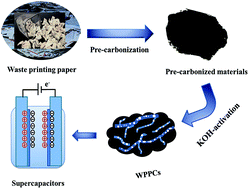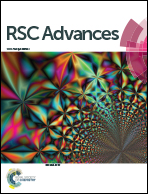Porous carbons derived from waste printing paper for high rate performance supercapacitors in alkaline, acidic and neutral electrolytes
Abstract
Renewable biomass as a precursor in the preparation of sustainable carbon materials for supercapacitors has gained much attention due to its huge reserves and being economical. In this paper, we used waste printing paper as the precursor to prepare highly porous carbons via a combined method of pre-carbonation and KOH activation. The prepared carbon materials exhibit huge specific surface areas and good conductivities as high as 2616.1 m2 g−1 and 198.8 mS cm−1, respectively. They were used as the electrode materials of supercapacitors in the most common aqueous electrolytes, including 6 M KOH, 1 M H2SO4, and 1 M Na2SO4, and showed excellent capacitive performance in all the investigated electrolytes, such as very high specific capacitances (e.g. 385.0, 370.1, and 317.7 F g−1 in KOH, H2SO4 and Na2SO4 electrolyte at 0.2 A g−1, respectively), outstanding rate capabilities (e.g. 198 F g−1 at 60 A g−1 in H2SO4), high energy densities (e.g. 21.9 W h kg−1 in Na2SO4), high power capability (at 28 000 W kg−1, remains at 5.83 W h kg−1 in Na2SO4), and good recyclability (about 94% retention after 10 000 cycles).

- This article is part of the themed collection: Biofuels and biomass for a clean environment


 Please wait while we load your content...
Please wait while we load your content...